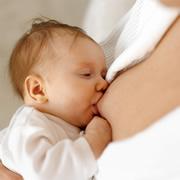 Breast is best: sugar chemicals in mother's milk could block HIV.© Punchstock
Breast is best: sugar chemicals in mother's milk could block HIV.© PunchstockSugar-containing compounds in breast milk may reduce the transmission of HIV to suckling babies, suggests a lab-based study.
The findings do not mean that it is a good idea for HIV-positive mothers to breastfeed their infants, say the researchers, as the virus can still be transmitted this way. But if the results hold true in further studies, they could lead to new ways to block transmission of HIV between adults during sex.
“If it does work as a microbicide, it would be a great tool”
David McDonald
Case Western Reserve University, Cleveland.
Milk is already known to contain some substances that quell HIV. "Breast milk has all sorts of good stuff in it, such as antibodies from the mother," says Louise Kuhn, who studies HIV transmission at Columbia University in New York.
Now Bill Paxton at the University of Amsterdam and his colleagues have homed in on anti-HIV compounds in milk that seem particularly powerful. They say the secret ingredient is Lewis X, a type of sugar also found in saliva and blood.
Blocking defence
HIV infects CD4 T cells, which are a key part of the immune system, and the destruction of these cells leads to AIDS. Some researchers think the virus can get to the CD4 cells by binding to a different set of immune cells known as dendritic cells.
Paxton and his team found that HIV cannot hitch a ride on these dendritic cells if compounds containing Lewis X have already bound to a particular protein on the cell surface. Dendritic cells are known to congregate in the tonsils, so they should get a high dose of the Lewis-X compounds in the milk as an infant drinks.
In some breast milk samples, the compounds stop HIV latching on to cells in a lab dish even when diluted 500-fold. The researchers report their results in the Journal of Clinical Investigation1.
Risk analysis
Whether milk blocks HIV in real life is an open question, cautions David McDonald, who studies the virus at Case Western Reserve University in Cleveland, Ohio.
"If this is an inhibitor, why do babies get HIV through breast milk?" he asks. Every year, about 200,000 infants acquire the virus from their mother's milk, according to UNICEF, the United Nations children's fund. Between 10% and 20% of infants with HIV-positive mothers catch the virus after being breastfed for two years.
Paxton counters that without protective substances such as the sugar, babies would probably get HIV more often.
Public-health experts argue about the risks and the benefits of breast milk for some infants, but guidelines from the World Health Organization call for HIV-positive mothers to use formula when "feasible".
Baby steps
Paxton now plans to investigate whether women who have high levels of the sugar compounds in their breast milk are less likely to transmit HIV to their offspring. "It's not the easiest study to do," he says, in part because ethics demand that infants be protected from HIV transmission where possible.
Paxton's ultimate aim is to find compounds that block HIV so they can be used in microbicides. These are gels or foams designed to block HIV transmission in the vagina during sex. Some experts say women are more likely to use microbicides than condoms, which require cooperation from partners. Perhaps in the future, a dose of the sugar molecule could be thrown into the mix.
"If it does work as a microbicide, it would be a great tool," says McDonald.
Case Western Reserve University, Cleveland.
